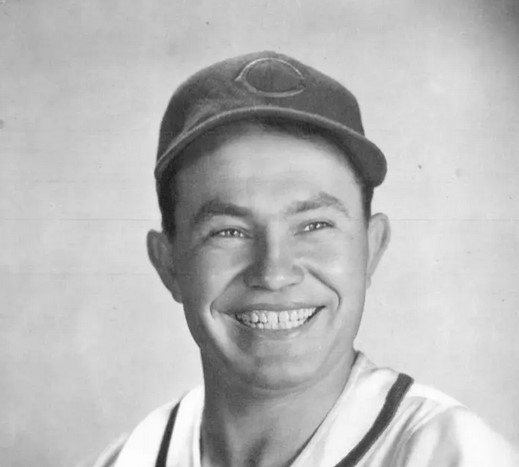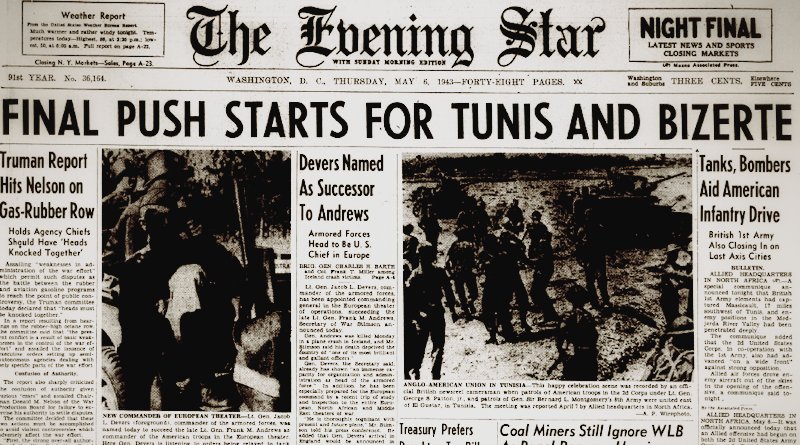World War II Chronicle: May 6, 1943
Click here for TODAY’S NEWSPAPER
On today’s front page: Lt. Gen. Jacob L. Devers has been picked to replace Lt. Gen. Frank Andrews as European Theater’s commanding general. Andrews was one of 14 American servicemen killed when a B-24 crashed into Iceland earlier this week. Among the fatalities is Brig. Gen. Charles H. Barth Jr., who like his father (Class of 1881) was a graduate of West Point (Honor Graduate, Class of 1925). Charles Jr. was Andrews’ Chief of Staff. A complete list of the casualties is on page six.. George Fielding Eliot talks about the state of the Luftwaffe on page 12…
Page 14 notes the passing of Arthur Lathrop, a 101-year-old Civil War veteran… Sports section begins on page 20, which reports that Cubs left fielder Lou Novikoff is wanting to be released if Chicago if they don’t offer him a bigger salary. “The Mad Russian” says he can make more in a defense job while playing semi-pro ball on the side. He does return to the Cubs and will join the Army Air Force in 1945.

When Gen. Omar Bradley and Marshal Ivan Konev celebrate the end of the war in Europe, they will also toast Novikoff… The story of “Torpedo 8” continues on page 40.
The Roving Reporter by Ernie Pyle
NORTHERN TUNISIA — (By Wireless) — The most freakish air victory over the Hun that I’ve heard about yet was accomplished unwittingly by Lt. Cowell Vandeventer of St. Louis.
Vandeventer is a Spitfire pilot. he joined the RAF when he was 17, and later transferred to the American Army. He’s 20 now.
It seems that Vandeventer and his friends spotted a German airdrome just as some German fighter pilots were taking off. So they went down after them. The others all got a German apiece, and then Van came in to have a finger in the pie. He swooped down over the top of one Hun fighter who was just off the ground, and disposed of him in short order. Then he kicked his plane over on one wing to make a fast turn, and as he did so his wingtip ran smack into another German fighter who was just taking off and whom he hadn’t seen at all.
Van’s wingtip went right through the cockpit, killing the pilot and the plane hit the ground instantly and blew all to pieces.
The entire tip was knocked off Van’s wing, but somehow he managed to get home safely. They say if he’d hit the Heinie four inches ahead or behind the spot he did actually hit, it would have thrown his plane to the ground and killed him.
While he was away on this short but fantastic flight, orders arrived at Van’s home field, sending him back to the States. So his spectacular day had doubly beautiful ending. He is probably back in the States by now telling about it, so this is just to confirm it in case you think he’s making it up.
Incidentally, so many pilots have been lost while going on one last mission after receiving orders to return to America that the group commanders now ground a pilot the moment such an order comes in. Nobody’s superstitious, of course, but you know there’s no sense pushing a good thing too far.
And speaking of superstitions, if any new ones have sprung up among fliers in this war I haven’t heard about them. In fact I’ve not yet run onto a single instance of the last war’s N. 1 superstition — against lighting three cigarettes on one match.
American fighting pilots these days are flying as much as five hours a day — every moment of it in combat. That doesn’t sound like much to a factory worker who may be doing 10 hours at his machine, but there’s a great deal of difference. The nervous strain is almost indescribable. You are constantly under a terrific strain, and when you spot the enemy the tension mounts to an absolute tautness. As one pilot said:
“When I’m in a fight and try to yell over the radio my mouth gets frozen and nothing comes out. All I do is sit there and lose weight.”
Five hours a day is 150 hours a month. That’s nearly twice as much as the government allows air-line pilots to fly back home, and nobody is shooting at them.
No pilot can stand up very long under such flying. That’s the reason we have rest camps scattered over Africa for combat pilots, where they go for 10 days or two weeks of relaxation.
My old Spitfire group that I visited in Northern Ireland, and again here in Africa a few weeks ago, is going stronger than ever these days. They had about 80 victories the last time I saw them, and they’re probably knocking around 100 now. Their losses have been about 30, and the pilots of some returned. Others are known to be alive as prisoners.
Despite being over-flown, their morale is magnificent. They still think the Spitfire is the next thing to a goddess. One of them said:
“I can’t understand why America won’t admit the Spitfire is the best fighter the Allies have and start building them in the States.”
Three of my old friends run the entire group now. Lt. Col. Windy West of Portland, Ore., is in full command. Maj. Jim Coward of Knoxville is executive officer, and Maj. Ralph Keyes of Cleveland is operations officer. All of them still lead missions occasionally.
The group’s leading ace is Lt. Sid Feld, of Lynn Mass., who had seven victories last time I looked. The way victories are piling up these days he may have 7,000 by the time this hits print.
If things keep on the way they’re going, I expect to take off on my witch’s broomstick and bring back a Focke-Wulf myself before long now.
2nd Lt. Cowell Vandeventer of the 4th Fighter Squadron bagged two enemies on March 22, 1943 and two more as a captain flying for the 410th Fighter Squadron on June 7, 1944.
Sylvan (Sid) Feld added two more victories in June, bringing his total to nine. Maj. Feld is killed in action while flying a P-47D over Argentan, France on Aug. 13, 1944. William S. Lyons will name his P-51 Tiger’s Revenge in honor of his fallen cousin Sid.
Evening star. (Washington, D.C.), 6 May 1943. Chronicling America: Historic American Newspapers. Lib. of Congress.
https://chroniclingamerica.loc.gov/lccn/sn83045462/1943-05-06/ed-1/
